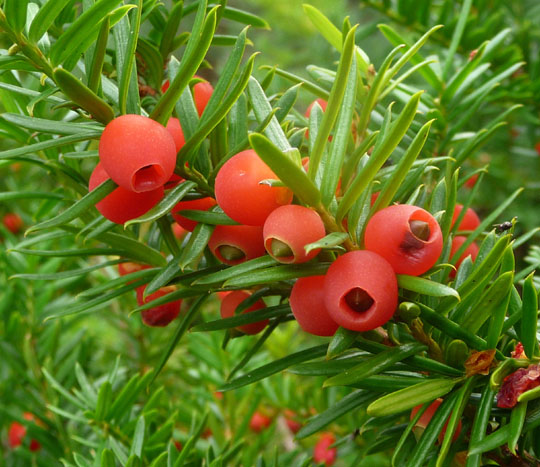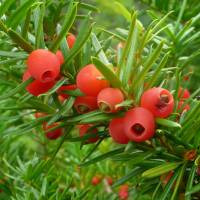The rotenburo (outdoor hot spring) that I most regularly frequent creates an excellent illusion of there always being a full moon bathing in its glow those soaking beneath.
The careful (or perhaps coincidental?) placing of a pale-yellow dome light that shines through a gnarled, dense-leaved pine tree gives an impression of Earth's sole natural satellite frozen in time just as it rises with two-thirds of its orb above the horizon. Its light, shining through the pine needles, also casts a slightly dark-green aura that blends in unnoticeably with other foliage during summer, but somehow it well suits the chilling winter season.
Trees, colors, and their varied associations, not least with fruits, berries and nuts, seem permanent fixtures with the seasons and with ancient seasonal festivals. Yet times change, the patterns of leafing, fruiting and leaf-fall are all shifting, and suddenly new color associations appear.
How is it, then, that after millennia of green and red emblazoned together being pagan symbols of midwinter before being coopted for Christmas, these colors have been knocked back into equal second place in the popularity ranking by blue?
It seems so recently that the very first blue light-emitting diodes (LEDs) appeared on the market after being created by the alchemy of modern physics for arcane uses in engineering by Shuji Nakamura in 1993 while he was working at the Tokushima, Shikoku-based Nichia Corp. A seeming novelty at first, blue LEDs have exploded upon us and are now found everywhere coupled with green as the new red in that arcane color combination that marks the return of the famously festive season.
Since 2006, railway companies in Japan have even been using them at stations and crossings to calm and uplift the mood of those considering suicide — for many such in this country choose trains to relieve them of their life's burdens — though with as yet undisclosed results.
Meanwhile, so ubiquitous have LEDs become that their blue lights in public displays seem now to function not only as the new counterpart to green, with which they mostly appear, but also as the new replacement for white.
It is the decline of the latter that affects me most, because tiny white lights with a hint of yellow are a link to the flickering flames of candles and to the crackling hearth fires of my English upbringing. So, for me, they impart the kind of inner physical and spiritual warmth that mulled wine also achieves.
In contrast, blue lights conjure up for me coldness, the coldness of frost and of the frigid depths of time and space, and I find them neither calming nor uplifting. I prefer the gentle warmth of white light that is nowhere better experienced than beside a northern European Christmas tree adorned with lit beeswax candles. Somehow, those natural waxen flames create a penumbra around the tree within which there is an aura of golden light and warmth. In the absence of genuine candlelight, give me white illuminations over blue, any night.
Through another kind of alchemy, pagan beliefs and Christianity's relatively recent traditions have been interwoven and have cross-fertilized each other to such an extent that extricating origins becomes increasingly difficult.
While sources contradict each other and spread confusion, there seems little doubt that onto the symbolism of paganism has been grafted the symbolism of a major monotheistic religion — upon which veneer after veneer of commercial capitalism has been applied.
Indeed, so much cultural transmission of Yuletide/Christmas traditions appears to have occurred that it has created a kind of global game of Chinese whispers as to their origins, with borrowing built on blending, following merging. It is perhaps not surprising that a friend living in Beijing reported Christmas banners, in famously non-religious China, that read: "Happy Birthday Santa!"
Celebration at and of the winter solstice seems the simplest and most fundamental human response to the hardships of the season. The cycle of the sun has reached its nadir and rebirth lies ahead. The last year's harvest may or may not be sufficient to see the community through the traditional "famine months" of the early part of the new year, and animals were often slaughtered then to save on fodder for them.
Certainly, for all those through the ages who have and still do live close to the land and nature, a brief celebration of plenty before potential hardship and famine seems as natural an event as a final feast before departing on a risky journey. And where better to feast in the dark months than around a soul-warming fire: light in the darkness.
Boughs of hardy holly and ivy would be taken into houses for those celebrations as symbolic survivors, in the hope that the households and communities would weather the remaining winter months as those evergreens do. The deep green of their foliage and the bright red of their berries were long the colors associated with the season — and now they are part of the Christmas' festivities, too
Today, traditional (though mostly artificial) Christmas trees around the world are green, while most people likely visualize Santa Claus wearing red and white — unaware, perhaps, of the influential role of Coca-Cola's 1930s Christmas advertising campaigns in cementing this image so relatively recently.
Although Christians have adopted green as the color of eternal life, and hence of Jesus Christ, and have linked it with red, as the color of his blood at the Crucifixion, the green of pine, holly and yew — as well as the now kiss-me-quick sprigs of mistletoe many like to position strategically at this time of year — are all of far more ancient provenance. Their roots long predate Christianity and stretch back into the mists of time at least to midwinter rites in the northern European tradition.
Not to be too Eurocentric, though, celebrations of the midwinter solstice, midwinter feasting, Yule, the rebirth of the sun, and year-end festivals of one kind or another are significant in cultures around the world from Antarctica to China, from Mali to Siberia — and most places between. The grafting of the birth of Christ, as the claimed new light in the world, onto this significant date is no mere coincidence.
The role of colors varies from culture to culture, thus red may represent anything, from anger to celebration, death and mourning, power and status (witness the red carpet), passion and love (think roses and hearts), patriotism and sacrifice. Red does, though, have one universal meaning — danger — as is evident from its use for international road signs.
Similarly, we may now associate the color green with a branch of politics, with environmentalism and ecological awareness, but its older associations are as conflicting as those of red. It may stand for love or fertility (in the Middle Ages in Europe, wedding dresses were commonly green), or for wealth. Yet green may also represent jealousy, poison, evil and even death — so making it lucky for some but quite the opposite for others.
So it is that, separately, green and red carry a multitude of different meanings, yet together have become the colors of the festive season — until those blue LEDs came along !
Gold, too, is linked with the now impending season, appearing frequently in decorations as a representative of light, warmth and wealth — perhaps in the same way mistletoe's pearly-golden berries were regarded by the Druids', for whom a sprig of mistletoe was their "golden bough."
The significance of mistletoe at this season relates to beliefs in the mysterious and magical properties of this plant that was held sacred in ancient European folklore. For the Druids, mistletoe — which often grows on oaks, which they held to be sacred trees — was a miraculous cure-all and a potent aphrodisiac and fertility symbol. Indeed, so powerful a plant did the Druids believe mistletoe to be that it was only to be cut with a golden sickle. So it's not for nothing that we kiss beneath the mistletoe, though it has nothing at all to do with Christianity.
Mistletoe's supposed powers don't stop there, because in a melding of Druidic belief and Anglo-Saxon superstition that attributes it to Freya, the goddess of beauty, love and fertility, branches of mistletoe are also often hung from ceiling beams or over doorways for the further purpose of warding away evil, and to prevent the entry of witches.
Nowadays, thanks to the wonders of libraries and online content, any quick trawl will at once yield countless claims and counter-claims as to the meaning and origins of everything we believe we know about Christmas celebrations — though few if any will relate directly to Christianity.
Even as long ago as the 2nd-century B.C.E., Christian commentators such as Tertullian were bemoaning the pagan practice adopted by many Christians of using lamps and laurel wreaths for Christmas.
Interestingly, too, Christmas trees as we know them may only date back as far as 14th-century church plays, known as miracle plays, that used such trees in staging the Adam and Eve story for illiterate parishioners. As apple trees — which take center stage in that Old Testament tale — were not in leaf in winter, pine branches were used instead, with red apples fastened to them as per the Bible. Consequently, evergreen trees became absorbed into the tradition of Christmas displays.
However, by the late 16th century Britain had fallen under the fierce sway of the Puritan general Oliver Cromwell — the conqueror of Scotland and Ireland and leader and Lord Protector of the brief republican Commonwealth of England. Puritanism was then at full strength, and you crossed the path of its authorities at terrible peril. Like Tertullian and others before them, the Puritans also damned as heathen the traditions and joyful exuberance of what Christmas had already by then become — with its decorated Christmas trees, holly, mistletoe and carols.
Though it was Puritans who became the Founding Fathers of a new British colony across the Atlantic, in both their homeland and North America — and much of the rest of the world — it now seems their attempts at suppression of joy and hope have succeeded only in spawning an explosion of exuberance which, though still called Christmas, has increasingly more to do with materialism than religion — and those LEDs be damned.
Here in Japan, though, is there any more potent a seasonal image than that of the bright-red, winter-flowering camellia against its own deep-green foliage — all, if you're lucky, dusted with snow? Symbolizing both winter and the relished fatalism of the once-common samurai lifestyle, the red camellia seems the perfect accompaniment for "Season's Greetings" to you all.
Mark Brazil, naturalist and author, has written Wild Watch for 29 years. Between global travels in search of wildlife, he organizes and leads wildlife, birding and photographic excursions around Japan as the founder of Japan Nature Guides. His books "Field Guide to the Birds of East Asia," "A Birdwatcher's Guide to Japan" and "The Birds of Japan" are available at good bookstores, or online with ease via [email protected] or at www.wildwatchjapan.com.



















With your current subscription plan you can comment on stories. However, before writing your first comment, please create a display name in the Profile section of your subscriber account page.